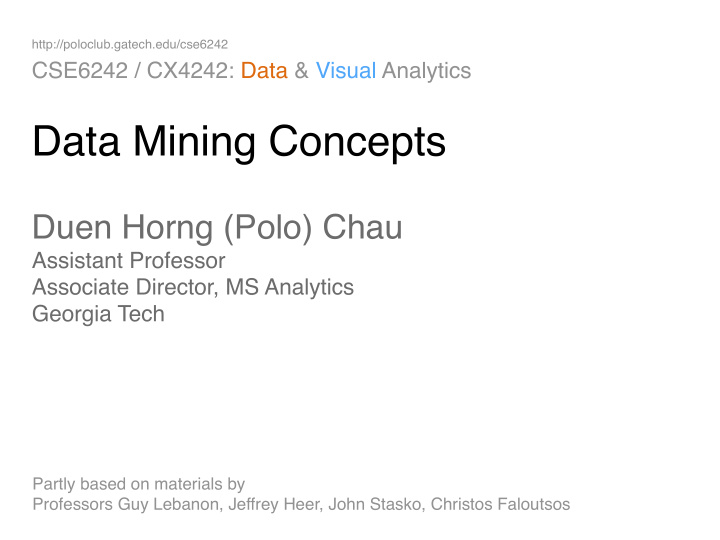



http://poloclub.gatech.edu/cse6242 CSE6242 / CX4242: Data & Visual Analytics Data Mining Concepts Duen Horng (Polo) Chau Assistant Professor Associate Director, MS Analytics Georgia Tech Partly based on materials by Professors Guy Lebanon, Jeffrey Heer, John Stasko, Christos Faloutsos
http://www.amazon.com/Data-Science-Business- data-analytic-thinking/dp/1449361323
1. Classification (or Probability Estimation) Predict which of a (small) set of classes an entity belong to. 3
(From previous class) 1. Classification (or Probability Estimation) Predict which of a (small) set of classes an entity belong to. • email spam (y, n) • sentiment analysis (+, -, neutral) • news (politics, sports, …) • medical diagnosis (cancer or not) • shirt size (s, m, l) • face/cat detection • face detection (baby, middle-aged, etc) • buy /not buy - commerce • fraud detection • census: gender 4
(From previous class) 1. Classification (or Probability Estimation) Predict which of a (small) set of classes an entity belong to. • Cancer testing (yes, no) • Movie genre (action, drama, etc.) • sports (win, loss) • email spam filter (spam, or not) • gesture detection (pinch, swipe…) • planet zone habitable or not • gene prediction • news types (sports, entertainment) • virus scanning (malware or not) 5
2. Regression (“value estimation”) Predict the numerical value of some variable for an entity. 6
(From previous class) 2. Regression (“value estimation”) Predict the numerical value of some variable for an entity. • stock value • real estate • wine valuation • food/commodity • sports betting • movie ratings • forex • any product sales • energy • spread of diseases (regression + geographical info) • web/commerce tra ffi c • GPA - how much time putting in?? 7
(From previous class) 2. Regression (“value estimation”) Predict the numerical value of some variable for an entity. • point value of wine (50-100) • credit score (start with classification; default or not) • stock prices — wall street • relationship between price and sales • weather • sports and game scores 8
3. Similarity Matching Find similar entities (from a large dataset) based on what we know about them. 9
(From previous class) 3. Similarity Matching Find similar entities (from a large dataset) based on what we know about them. • dating • recommender system (movies, items) • customers in marketing • price comparison (consumer, find similar priced) • comparing emails if they’re spam or not? • facebook/trend/friends suggestions • finding employees • similar youtube videos (e.g., more cat videos) • similar web pages (find near duplicates or representative sites) ~= clustering • plagiarism detection 10
(From previous class) 3. Similarity Matching Find similar entities (from a large dataset) based on what we know about them. • recommending items you may want to buy • find similar gene sequences (that may be repeating, or does similar things) • online dating • building auditing (energy consumption) • patent search • carpool matching (find people to carpool) • detecting fake identities 11
4. Clustering (unsupervised learning) Group entities together by their similarity. (User provides # of clusters) 12
(From previous class) 4. Clustering (unsupervised learning) Group entities together by their similarity. (User provides # of clusters) • groupings of similar bugs in code • optical character recognition • unknown vocabulary • topical analysis (tweets?) • land cover: tree/road/… • for advertising: grouping users for marketing purposes • fireflies clustering • speaker recognition (multiple people in same room) • astronomical clustering 13
(From previous class) 4. Clustering (unsupervised learning) Group entities together by their similarity. (User provides # of clusters) • cluster people into demographics groups (young, old, etc) • cluster people by accents (y’all, you all) • hierarchical clustering for metabolomics • clustering images on the web (cat?) • ~ = dimensionality reduction 14
5. Co-occurrence grouping (Many names: frequent itemset mining, association rule discovery, market-basket analysis) Find associations between entities based on transactions that involve them (e.g., bread and milk often bought together) http://www.forbes.com/sites/kashmirhill/2012/02/16/how-target-figured-out-a-teen-girl- 15 was-pregnant-before-her-father-did/
6. Profiling / Pattern Mining / Anomaly Detection (unsupervised) Characterize typical behaviors of an entity (person, computer router, etc.) so you can find trends and outliers . Examples? computer instruction prediction removing noise from experiment (data cleaning) detect anomalies in network tra ffi c moneyball weather anomalies (e.g., big storm) google sign-in (alert) smart security camera embezzlement trending articles 16
7. Link Prediction / Recommendation Predict if two entities should be connected, and how strongly that link should be. linkedin/facebook: people you may know amazon/netflix: because you like terminator… suggest other movies you may also like 17
8. Data reduction (“dimensionality reduction”) Shrink a large dataset into smaller one, with as little loss of information as possible 1. if you want to visualize the data (in 2D/3D) 2. faster computation/less storage 3. reduce noise 18
Start Thinking About Project! • What problems do you want to solve? • Using what (large) datasets? • What techniques do you need? 19
Recommend
More recommend